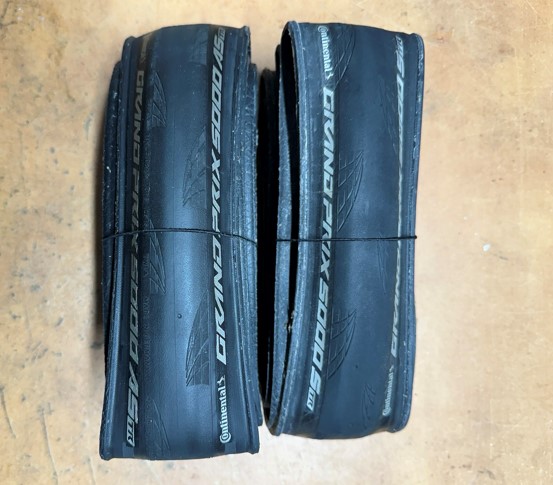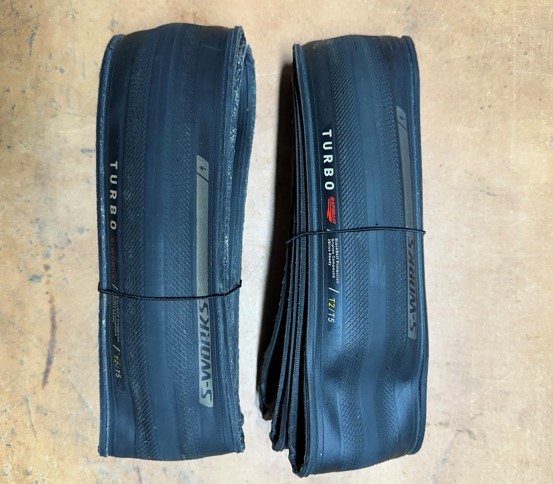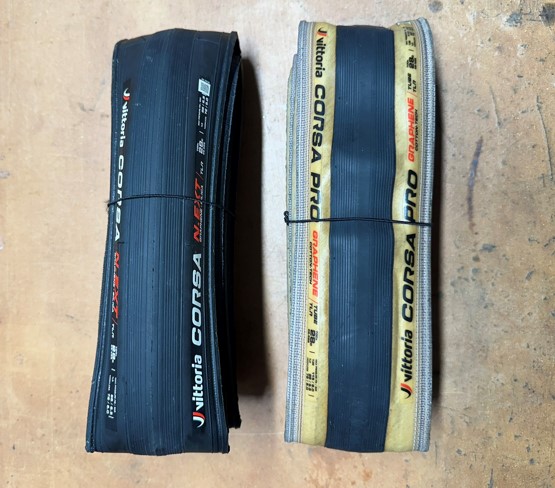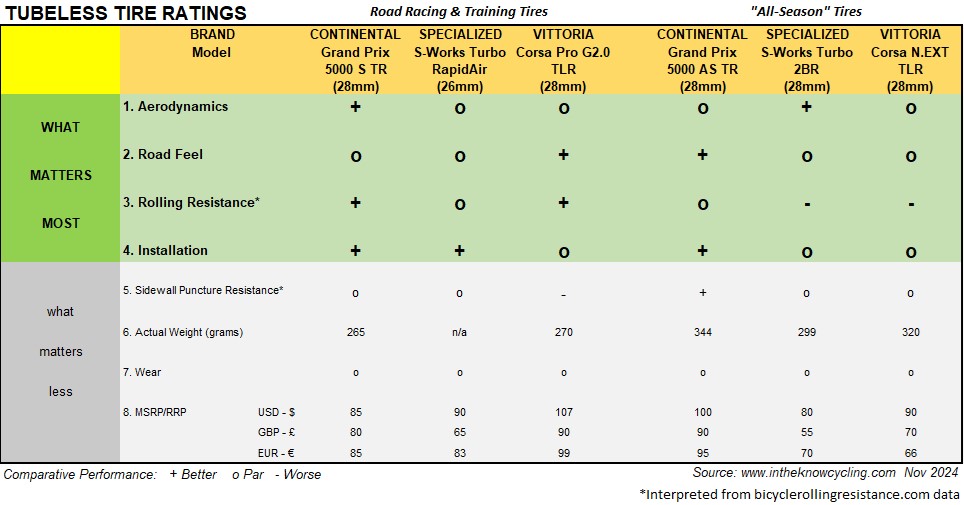BEST ALL-SEASON BIKE TIRES

What are the best all-season bike tires?
It’s a question I’ve been trying to answer over the last year.
Where I ride in the New England region of the United States, the roads aren’t as clean in the fall, winter, and spring as they are during the summer. So I’m looking for more puncture protection during those seasons.
Yet I still want to be fast for those beautiful fall rides before the weather forces me inside. And with all the indoor training I do during the winter, I want to be flying when I get back outside in the early spring.
If I do get out on a sunny winter day when the roads have more grit, sand, and water than normal, I want plenty of grip to go with my speed and puncture protection.
Not too much to ask for, right?
JUDGE CLINCHER AND TUBELESS ALL-SEASON TIRES DIFFERENTLY
I moved on long ago from regular season clinchers and tubes to tubeless tires that are faster, more comfortable, handle better, and are more puncture-resilient. Should I judge tubeless all-season bike tires as tube-free versions of the old Gatorskin or Hardshell clincher tires or evaluate them differently?
Many major tire manufacturers sell tubeless tires with all-season names or descriptions. Yet some, like the Pirelli P Zero Race TLR 4S and Hutchinson Fusion 5 All Season, have tire rolling resistance scores as measured by Bicycle Rolling Resistance (BRR) drum tests that are 6-8 watts slower than a benchmark road racing and training tire like the Continental Grand Prix 5000 S TR.
With the added rolling resistance, some 60-75% more than what I’m rolling on in the late spring and summer, those all-season tires aren’t fast.
True, the puncture resistance scores of the treaded parts of the Pirelli and Hutchinson all-season bike tires are nearly twice as good as the GP 5K S TR. However, I consider tread puncture resistance a more useful measure for clincher tires and less for tubeless ones.
Most tread punctures in tubeless tires will close with the right amount and concentration of sealant already waiting in your tires. Unlike a tread puncture in a clincher tire, you normally won’t need to get off the bike, remove your wheel, and replace your tube.
Far less common sidewall punctures will likely be larger, not as readily sealed, and may require you to put a plug or tube in a clincher or tubeless tire to get back underway. But the sidewall puncture scores between the Pirelli and Hutchinson all-season bike tires and those I selected for testing aren’t that different.
So while I want a little more puncture resistance in the tires I’m riding in the fall, winter, and spring, I’m more comfortable if I’ve got some fresh sealant in my tires than their tested puncture resistance scores.
Sealant makes tubeless tires more puncture “resilient.” Its condition is a better predictor of whether I’ll have to stop along the side of the road to fix my tire than puncture resistance. The sealant condition is also something I can take responsibility for and control each season.
I’m also unwilling to use a tire that gives up much rolling resistance, road feel, and aero performance to get proportionately more puncture resistance based on needle pricks delivered in a lab to the tread and sidewall of tubeless tires.
HOW I SELECTED AND EVALUATED TIRES FOR THIS REVIEW
With my experience-based faith in sealant, I’ll admit that I’ve ridden my Conti GP 5K S TR and other fast tubeless tires in the early fall when I’ll occasionally roll over acorns and leaves and early spring when sand and salt from snow plows and water from melting snow banks still cover the edges of the road.
At the same time, I’ve always wanted to extend the life of my best tires by replacing them with something nearly as good that also gives a bit of a middle finger to the elements during the shoulder seasons and winter months.
With all of that in mind, I picked three tubeless tires sold by companies whose top everyday tubeless tires my fellow testers and I have rated among the best tubeless bike tires for everyday summer road racing and training.
Each is just one step away from those top tires in the company’s tire hierarchy, has slightly worse rolling resistance but better puncture resistance scores, and is described by the company in terms that I take to mean that they are more durable.
While only one has the “all-season” name, I treated each as though they can be ridden in the fall, winter, and spring in addition to summer and call them all-season bike tires going forward.
The all-season tires and the ones above them in their product lines I tested are:
Continental Grand Prix 5000 All Season or “AS” TR and Grand Prix 5000 S TR
Specialized S-Works Turbo 2Bliss Ready T2/T5 and S-Works Turbo Rapid Air 2Bliss Ready
Vittoria Corsa N.EXT TLR and Corsa Speed G+ 2.0
I considered the Vittoria Corsa Pro Control TLR instead of the Corsa N.EXT, but the N.EXT has slightly better rolling resistance and puncture resistance scores in BRR testing.
For this review, I compared each all-season bike tire to its sibling and each other. I rode the tires in A:B and A:B:C testing and alone on various rides and road surfaces during the spring, summer, and fall.
To aid the comparisons, I used 28mm wide sizes of each tire except for the RapidAir which only comes in a 26mm size.
As with our reviews of the best tubeless bike tires, I evaluated these all-season ones on eight criteria that should help you pick the best.
The first four criteria matter most.
1. Aerodynamics of the rim-tire combination – Generally, the larger the ratio of the rim’s external width to the tire’s installed width, the more aero the combination. In the past, it was thought that the ratio of any rim and tire combination needed to be 1.05 to 1 or better, abiding by a so-called “rule of 105.” This came from Zipp’s wind tunnel tests of some of the first deep carbon Firecrest bike wheels over 20 years ago.
With modern rim widths and shapes and how rims are engineered at the intersection with tires, computational fluid dynamics (CFD) and wind tunnel tests show no common ratio where aerodynamic drag is minimized or below which aero performance drops precipitously.
My research on this topic, including discussions with engineers at leading wheelmakers, concluded the width ratio of the best wheels is normally above 1:1, but that modern rims are designed to achieve optimum aero performance with a benchmark tire rather than to meet or exceed a given ratio.
2. Road feel – How comfortable the tire is, how well it handles in corners or maneuvers when you’re changing direction, and how much grip it provides in those handling maneuvers and when accelerating or just speeding along going straight.
3. Tire-loss rolling resistance – Watts of rolling resistance from tests done by BRR and other independent sources. Note that this only addresses the rolling resistance losses in your tire’s compound and casing.
Another, often more important source of rolling resistance is the vibrational losses when your tires come up off the road surface and land back. Those micro-vibrations happen over and over and over during a ride, especially on worn and rougher road surfaces. However, vibrational loss rolling resistance is more a function of your inflation pressure than specific to the tire itself.
4. Inflation ease – How easy it is to mount, inflate, seal, and remove your tire. This is usually only important when you first install a tubeless tire or need to remove a bead to check your sealant or install a tube. For a tire that’s difficult to mount, inflate, seal, or remove at any time, this can be a hassle and enough of a reason to choose one that’s easier to deal with regardless of how it performs on other criteria.
These four criteria that matter less for reasons I explain:
5. Sidewall puncture resistance – As described earlier, tread puncture resistance is more important for clincher tires that require you to replace a tube if you get a puncture than for tubeless tires whose fresh sealant will fill most tread punctures. Sidewall punctures are much less common but a tire’s resistance to them is worth considering.
6. Weight – This is less important as the weight differences among the same category of tires (time trial, road racing, or all-season) are usually very small and inconsequential in their relative performance.
7. Wear – While important, wear depends uniquely on what and how we ride. I never test tires long enough to compare their wear rates, but if I see one that wears particularly fast, I’ll note it in the review. While most of us roadies are frugal, I will pick a better-performing tire over a long-lasting one every day of the week.
8. Price – Again, performance trumps price, but most tires in the same category are typically priced within 20 US$, £ and € of each other. When you consider what it costs to buy and maintain a bike and the importance of tires to your performance and experience, you get one of the best returns on what you spend buying the best tires, almost no matter what you spend. Don’t cheap out!
You can read more about these criteria in my review of the best tubeless bike tires.
SOME RESULTS ARE SURPRISING, OTHERS LESS SO
There are some results I expected to see and a few surprises from my tests of the all-season bike tires compared to their everyday road racing and training siblings.
None of the all-season tires feels as fast on the road as their siblings. While I didn’t expect any would, I hoped that one of the all-season models might be close enough to allow me to switch to one tire for the entire season and be done with it.
This is also borne out by BRR’s testing that shows each all-season tire has 3-4 watts more rolling resistance than its faster sibling.
However, it is a surprise to see that the Continental AS TR tire rolling resistance is only a watt or so higher than that of the Specialized S-Works Turbo RapidAir and Vittoria Corsa Pro G2.0, the fastest road racing and training tires from those companies.
Of course, aerodynamics, handling, grip, and comfort, the latter three that combine into what I call “road feel,” also matter when picking a fast tire. More on how these tires compare on those criteria below.
Unsurprisingly, each of the all-season tires has a notably higher tread puncture resistance score than their faster siblings. As I explained above, I find these scores less important in tubeless tires, where the condition of your sealant is more important.
However, the sidewall puncture resistance scores provided three interesting and somewhat surprising contrasts.
First, two of the all-season bike tires – the Vittoria Corsa N.EXT and Specialized S-Works Turbo 2Bliss Ready T2/T5 – provided almost no added sidewall resistance than the Continental Grand Prix 5000 S TR, my recommended best tubeless tire.
Additionally, Specialized’s all-season tire offers marginally less sidewall puncture resistance than its best racing tire, the S-Works Turbo RapidAir 2Bliss Ready model.
Finally, Continental’s Grand Prix 5000 AS TR gets higher scores for sidewall puncture resistance than the company’s S TR and the other all-season and road racing and training tires I compared in this review. As the warning goes, your results may vary.
ROAD FEEL, INSTALLATION, AND AERODYNAMICS NOTABLY DIFFER
In addition to its better rolling resistance and sidewall puncture resistance, I rate the Continental Grand Prix 5000 AS TR notably better than the Specialized and Vittoria all-season tires on two other criteria I find matter most when choosing tires.
Road Feel
The Conti all-season tire handles and gripps the road wonderfully, better in my experience than the two other all-season tires and its S TR sibling. I rate the AS TR tire in the same plus neighborhood and nearly on par with the road feel of the Vittoria Corsa Pro, which has a cotton casing.
The Conti AS TR and Vittoria Corsa Pro feel different on the road. The former comforts you like an absorbent sponge, while the latter is more pillow-soft. They each hold smooth surfaces and rough ones with total confidence.
It’s somewhat remarkable to me how two such dissimilar tires can produce comparable road feel results, albeit in different ways. I am not interested in diving into the product details and marketing claims to understand or explain how they come to similar results. I just like the outcome.
In comparison, the Specialized all-season tire rides firmly but doesn’t handle as responsively as the Continental model. The Vittoria N.EXT handles well but with a bit more spring at the same tire pressure than the other two. Lowering the pressure to improve comfort makes it a bit less responsive when cornering.
Admittedly, road feel is subjective. After riding and comparing a lot of different tires over various road conditions, this is what I experienced.
Installation
Installing the Continental, Specialized, and Vittoria all-season tires is what I would hope for and expect from modern tubeless tires on tubeless rims.
Each goes on without needing to use tire levers and easily inflates with just a track pump. Along the way to about 70 psi, the beads lock into the rim shelf with those satisfyingly loud pings.
That said, the Conti mounts a bit easier than the other two all-season tires, a consideration that those without the experience I’ve developed over years of installing a crapton of tubeless tires might not bring to the party.
After moving the first bead and most of the second into the rim’s center channel, it only takes me a few hard thumb presses to get the remainder of the second Conti bead over the rim edge.
By contrast, the Specialized and Vittoria tires fit tighter and require a series of thumb pushes and finger pulls for about a minute more to get them over the edge. I can get it done quicker with a tire lever, but I don’t like to use a tool if I don’t have to around my carbon rims, and I don’t need to with any of these tires if I follow good technique and a bit more sustained effort.
All three tires hold air with sealant as well as the best tubeless tires do. Taking them off the rims is also easy with a couple of tire levers.
Aerodynamics
The Specialized S-Works Turbo 2Bliss Ready sets up narrower (29.7mm) and theoretically more aerodynamically than the Continental (30.7mm) and Vittoria (31.1mm), which measure about the same when inflated to 60 psi on my ENVE SES 4.5 front rim (25.3mm internal, 32.8mm external).
While I don’t have computational fluid dynamics (CFD) software or wind tunnel access to confirm this, with each tire being narrower than the front rim, air passing over the tires should reattach to the rim’s leading edge to create an aerodynamic airfoil and take advantage of the rim depth.
I didn’t measure the inflated widths of these all-season tires on rims with narrower internal and external widths. However, measurements I’ve done on the best road racing and training tubeless tires on narrower rims showed that the inflated widths of 28mm tubeless tires measure about 1mm less on 23mm internal with rims than on 25mm ones and another 1mm on 21mm ones.
From that, I conclude that the Specialized all-season tire will continue to be narrower, and airflow will reattach on rims with 23mm internal and at least 29mm external widths and 21mm internal and at least 28mm external widths.
The Continental and Vittoria tires will likely require rims about 1mm wider externally to maintain similar aerodynamic benefits from deeper rims at >20mph/32kph speeds.
If you have shallow rims or don’t ride at those speeds, none of this will matter – you won’t experience any meaningful aerodynamic benefits or losses from varying rim and tire widths.
WEIGHT AND PRICE DIFFERENCES FAVOR SPECIALIZED
Each of the all-season tires is considerably heavier than their road race and training tire siblings. The Continental AS TR is about 80g heavier on my scale than the S TR, and the Vittoria Pro Corsa and Corsa N.EXT are about 50g apart.
Specialized’s siblings differ by about 60g, though the lighter Turbo RapidAir is only sold in a 26mm width tire while the heavier Turbo I tested in a 28mm size is the narrowest size they make in that model.
Comparing the all-season tires, the actual weight of the Specialized (299g) is about 20g lighter than the Vittoria (320g) and 45g lighter than the Continental (344g).
The manufacturer recommended retail prices (MSRP and RRP) for the Specialized all-season tire (US$80, £55, €70) also beat those of the Vittoria (US$90, £70, €66) and Continental (US$100, £90, €95).
Of course, actual market prices fluctuate and are usually less than the MSRP/RRP. Here are the links for these tires to stores I recommend for their competitive prices, product selection, customer satisfaction, and support of In The Know Cycling.
- Continental Grand Prix 5000 AS TR – BTD (BikeTiresDirect) 10% off w/code ITK10
- Specialized S-Works Turbo 2Bliss Ready T2/T5 – Performance Bike, Sigma Sports
- Vittoria Corsa N.EXT TLR – BTD (BikeTiresDirect) 10% off w/code ITK10
SUMMARY AND RECOMMENDATIONS
The Continental Grand Prix 5000 AS TR gives up aero performance and rolling resistance I get from the S TR which is the best road racing and training tire I’ve tested and my benchmark for all tires. However, the AS TR also gives me more road feel and puncture resistance, two things I value when riding on more variable road conditions in the fall, winter, and spring.
On each of those criteria except its aero performance, it does better than the Specialized and Vittoria all-season models and is slightly easier to install.
Yes, it costs and weighs more than the Specialized S-Works Turbo 2Bliss Ready T2/T5. However, neither of those differences is significant or important enough to overcome the Conti AS TR’s better performance and faster ride on the road.
Taking all of that together, I recommend the Continental Grand Prix 5000 AS TR as the best all-season bike tire.
* * * * *
Thank you for reading. Please let me know what you think of anything I’ve written, or ask any questions you might have in the comment section below.
If you’ve benefited from this review and want to keep new ones coming, buy your gear and kit after clicking the store links in this review and others across the site. When you do, we may earn an affiliate commission that will help me cover the expenses to create and publish more ad-free, subscription-free, and reader-supported reviews that are independent, comprehensive, and comparative.
If you prefer to buy at other stores, you can still support the site by contributing here or buying anything through these links to eBay and Amazon.
You can use the popup form or the one at the bottom of the sidebar to get notified when new posts come out. To see what gear and kit we’re testing or have just reviewed, follow us by clicking the icons below.
Thanks, and enjoy your rides safely! Cheers, Steve




Another great article. I have been using the GP 5000 in a 35, yes they make them that big now….They are mounted tubeless on Roval Terra CL wheels with Stan’s valves since the Roval ones are cheap plastic that leak. I’ll put some Fillmore valves on there at some point. The bike is a new Canyon Endurace SLX with 105 Di2. I use gravel wheels and wide tires because I’m a big guy. I thought 32 was my new sweet spot but it turn you to be 35’s. 6’2″ and I won’t say how much I weigh…I remember riding 203c tres pumped up to 110 in the 80’s…these are a little over 60psi. Can’t say a bad thing about the setup or tires. I did four rides on a Roubaix with the Spesh tires and those seemed good too. By chance I did buy the Tires from Bike Tires Direct.
Another one to consider is the Michelin Power Protection tire. I suspect it has higher rolling resistance than Contis, but I haven’t seen it tested yet on BRR. It may have better flat protection though.
When the Conti S TR and the Conti AS TR came out I immediately bought a pair of each for my road and gravel bikes and haven’t looked back…just keep rotating and replacing as necessary
Aerodynamics lol….I’m using the AS TR setup up tubeless on Roval Terra CL II’s on my Canyon Endurace in a 35mm. Loving them.
I recently bought the AS TRs in 28mm and was shocked by how fast, comfortable and light they feel (despite their weight), I guess the active comfort technology actually works. I do feel like they are more of race/training tire than a true all-season in the traditional sense but they get a lot of 5 star reviews highlighting the durability and puncture protection so hopefully they will last me a while. Honestly it might be the best tubeless tire I’ve used as far as road feel goes, considering how stiff the tires felt when I unboxed them I was really surprised by how they ride. I haven’t ridden the S TRs since the low puncture protection scores on BRR’s tests make me nervous but I will have to buy them at least once and hope for the best if they have a better road feel than the AS TRs. I have not tried this Specialized tire but I’ve ridden the Vittoria N.EXT and they really don’t compare to the AS TR in my opinion, they are comfortable once “broken in” but for me they felt somewhat sluggish. I can’t feel any of the rolling resistance with the AS TR, I’m not measurably faster on them of course but they are much more thrilling to ride.